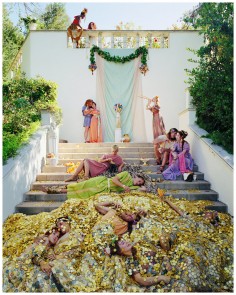Eleanor Antin
엘레 앙탱
אלינור אנטין
ЭЛЕОНОРА АНТИН
The Golden Death
source: pbsorg
“The Golden Death” from “The Last Days of Pompeii,” 2001
Chromogenic print, 58 5/8 x 46 5/8 inches
Courtesy Ronald Feldman Fine Arts, New York
“We finished this piece two-and-half weeks before 9/11…So the relationships between America as this great colonial power and Rome- one of the early, great colonial powers- were extremely clear to me.”
– Eleanor Antin
.
.
.
.
.
.
.
source: artsynet
The core of Eleanor Antin’s performances, films, photographs, written texts, and installations is her wide cast of alter egos from both historic and contemporary times, who explore issues of age, race, sex, and class. As critic Kim Levin aptly said, by “impersonating the past, Antin personalizes the issues and dilemmas of the present.” Antin began creating Conceptual art in the 1960s, and in the ’70s became widely known for using then-unconventional narrative forms in her artwork, such as autobiography and impersonation, always with a transgressive, deadpan humor. One of her most famous characters was Eleanora Antinova—an imagined forgotten black ballerina from Sergei Diaghilev’s productions—as whom she has written a fictitious memoir and made films, drawings, and performances.
.
.
.
.
.
.
.
source: pbsorg
Eleanor Antin was born in New York City in 1935. An influential performance artist, filmmaker, and installation artist, Antin delves into history—whether of ancient Rome, the Crimean War, the salons of nineteenth-century Europe, or her own Jewish heritage and Yiddish culture—as a way to explore the present. Antin is a cultural chameleon, masquerading in theatrical or stage roles to expose her many selves. Her most famous persona is that of Eleanora Antinova, the tragically overlooked black ballerina of Sergei Diaghilev’s Ballets Russes. Appearing as Antinova in scripted and non-scripted performances for over a decade, Antin has blurred the distinction between her identity and that of her character. In the process, she has created a rich body of work, detailing the multiple facets of her beloved Antinova, including a fictitious memoir and numerous films, photographs, installations, performances, and drawings. In her 2001 series “The Last Days of Pompeii,” Antin lingers behind the camera to stage the final, catastrophic days of Pompeii in the affluent hills of La Jolla, California. In “The Golden Death” from this series, the imagined citizens of Pompeii drown in the excess of their own wealth—an ironic parable of American culture in the throes of over-consumption. Eleanor Antin received a Guggenheim Foundation Fellowship in 1997 and a Media Achievement Award from the National Foundation for Jewish Culture in 1998. She has had numerous solo exhibitions, including an award-winning retrospective at the Los Angeles County Museum of Art in 1999. Antin is a highly respected artist and teacher, and has been a professor at the University of California, San Diego, since 1975. She lives with her husband and son in southern California.
.
.
.
.
.
.
.
source: technionphoto
Eleanor Antin (אלינור אנטין) – אמנית קונספטואלית אמריקאית העוסקת בצילום, וידאו ומיצג. עבודותיה עוסקות בהיסטוריה כללית ובהיסטוריה של האמנות בפרט. Antin עוסקת באמנות רומא, אמנות המאה-19 או במורשתה היהודית ובתרבות היידיש, כדרך לחקור את ההווה.
Antin נולדה ב-1935, ופרצה לעולם האמנות בשנות ה-60, מאז הציגה עשרות תערוכות יחיד ברחבי העולם וזכתה בפרסים רבים על עבודתה. משנת 1975 היא מלמדת, כפרופסורית, באוניברסיטת קליפורניה, בסן דייגו.
מבקרים וחוקרי אמנות מכנים אותה ‘זיקית תרבותית’, המשתנה ומחליפה מסכות דרך עבודותיה התיאטרליות החושפות את צדדיה השונים.
בעבודתה,” The Last Days of Pompeii ” (ימיה האחרונים של פומפיי) היא מתארת סצינות הירואיות כמטאפורה לתרבות הצריכה האמריקאית, ה”צורכת” את עצמה למוות.
מצורפים כמה צילומים מהסדרה – “The Last Days of Pompeii”, תהנו.
.
.
.
.
.
.
.
source: artsblogit
I video e le fotografie di Eleanor Antin rispecchiano il suo amore per lo stile Rococò. Non si può dire infatti che le scenografie scelte dall’artista e performer concettuale siano minimaliste.
Sulla scena da oltre 35 anni, la Antin negli ultimi cinque anni ha abbandonato il lato cupo di un tempo per far posto all’aspetto mitologico. Al centro della sua ricerca stilistica una Roma e una Pompei in piena fase di grandezza e decadenza, che l’artista ritiene simile allo stato attuale dell’impero americano e dell’Europa. L’eccessivo benessere del passato, come ritratto in “Roman Allegories” e “The last days of Pompeii”, paragonato all’iperconsumismo attuale.
.
.
.
.
.
.
.
source: the-wrong-guyblogspot
H Eleanor γεννήθηκε το 1936 στη Νέα Υόρκη. Μια πολυσχιδής προσωπικότητα, μια αληθινή καλλιτέχνιδα, καταπιάνεται με βίντεο, φωτογραφία και installation. Βουτάει στην ιστορία σαν φυσιοδίφης είτε πρόκειται για την αρχαία Ρώμη, είτε για τα ευρωπαϊκά σαλόνια του 19ου αιώνα. Μία πολιτιστική χαμαιλέοντας που παίρνει μορφές και αλλάζει προσωπεία αποκαλύπτοντας κάθε φορά ένα διαφορετικό κομμάτι του εαυτού της. Εδώ θα παρακολουθήσουμε τη βουτιά της στην αρχαίο ελληνικό και ρωμαϊκό κόσμο.
Το 2001 δημιούργησε τη σειρά φωτογραφιών “Οι τελευταίες μέρες της Πομπηίας” η οποία έκανε μεγάλη αίσθηση στο παγκόσμιο καλλιτεχνικό γίγνεσθαι. Στην πιο γνωστή εικόνα, οι φανταστικοί κάτοικοι της αρχαίας πόλης καταπλακώνονται όχι από λάβα αλλά από τα ίδια τους πλούτη.


